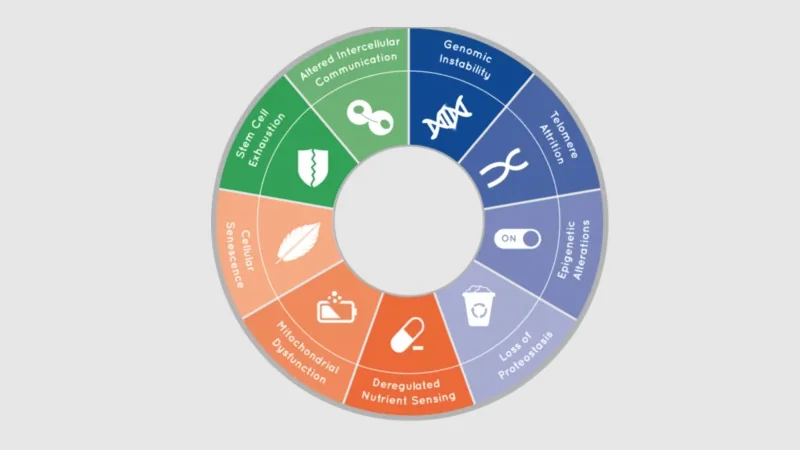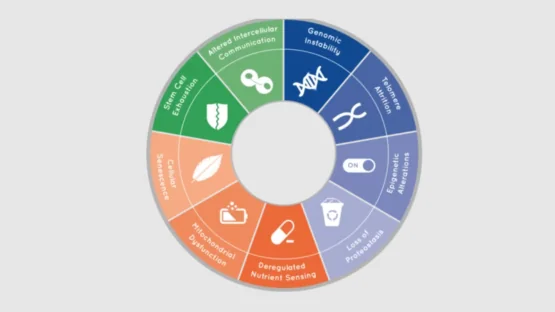The hallmarks of aging, as presented in a 2013 paper [1], have been useful but do not provide a genuine explanatory paradigm, argue David Gems of University College London and João Pedro de Magalhães of the University of Liverpool in a pre-print paper [2]. They propose that biogerontology would benefit from replacing the hallmarks with a framework that provides a basis for understanding the mechanistic underpinnings of the diverse aspects of aging.
An idea with merit…
The authors aren’t arguing against the utility or value of the hallmarks. “The hallmarks are a very nice introduction to the field, which we both recommend to students,” explained Dr. de Magalhães. However, they argue that the hallmarks should not be taken as the final word in aging because they don’t have sufficient explanatory power. “The issue is that in the past few years, people have taken the hallmarks far too seriously,” explains de Magalhães. “I think the hallmarks can be useful to biogerontology as a non-exhaustive list of hypotheses to be tested, not as a dogma, and not by assuming that they are all there is in mechanisms of aging.”
The paper starts by tracing the motivation behind the hallmarks of aging to the hallmarks of cancer. According to this account, the hallmarks of aging aimed to accomplish for biogerontology what the hallmarks of cancer had provided for oncology: a conceptual structure that unites various mechanisms into an explanatory framework and guides further successful research in the field. As the authors point out, this is a specific use of the term ‘hallmark’ to mean an element of this explanatory framework rather than its common meaning, ‘a typical characteristic’.
This is the goal against which the hallmarks of aging are then measured. The 2013 Hallmarks paper is perhaps the most cited paper in the field of longevity research, and researchers often refer to one or more hallmarks in a paper or presentation as a way to legitimize the relevance of research to longevity. The hallmarks are also used as a conceptual map of the field, guiding where researchers position themselves and the directions they pursue. It is important to evaluate whether the hallmarks merit such a central, dominant role in the field.
…taken too far
The paper describes the hallmarks as “an original and brave attempt to restore order to a jumbled subject” but argues that they do not succeed in the same way that the hallmarks of cancer did. The hallmarks of aging follow the template of the hallmarks of cancer, in which a primary cause or mechanism results in a set of secondary alterations, leading to different forms of disease. However, the authors argue that this, in fact, obscures the uncertainty in the field rather than increasing explanatory power.
The first problematic element is the primary cause embedded in the models. In the case of cancer, the primary mechanism is the mutation of tumor suppressors and proto-oncogenes. This underlies a set of secondary causes, which are the hallmarks of cancer. The authors argue that the hallmarks of aging paper makes an analogous claim that the accumulation of cellular damage is the main driver of aging, the primary cause that then leads to the hallmarks are secondary causes. In both cancer and longevity research, the primary cause is implicit in the model rather than being part of the hallmarks. However, while mutation is generally considered the driver of cancer by oncologists, Drs. Gems and de Magalhães contend that cellular damage is not universally agreed upon as the primary cause of aging. Other potential primary mechanisms were being discussed at the time, according to them, and the hallmarks of aging sidestep these and maintain the cellular damage paradigm as a hidden component of the model.
“I don’t think that damage is necessarily the driving force of aging, which is the underlying assumption of the hallmarks,” de Magalhães stated. “I think there are programmatic features of aging that are likely important.”
In addition, the authors contend that the list of hallmarks linked with aging is relatively arbitrary. They point out that a review published around the same time identified seven pillars of aging, only three of which were also listed in the hallmarks paper. This is because biogerontology was – and still is – a relatively immature field with a variety of factors and theories proposed to underlie aging. In principle, the hallmarks of aging should bring unity to this confusion by providing an effective basis for deciding which factors to include, a task at which Gems and de Magalhães claim they fail.
Further criticisms include a lack of justification for the hallmarks’ distinction between primary, secondary, and tertiary causes of aging, as well as doubts about whether the hallmarks all arise as consequences of the unspoken primary cause, which is accumulated cellular damage as a whole. Gems and de Magalhães also argue that the hallmarks fail to explain how these secondary causes combine to give rise to aging, in part because of a lack of clarity about what ‘aging’ means – in particular, whether aging is an independent process that increases the risk of age-related diseases or whether the two are part of the same process.
Looking forward
The paper goes beyond merely critiquing and also offers a sketch of what a successful paradigm of aging might look like. They propose that it should include multiple primary causes of aging, and they list several to consider. The resulting multi-cause model would look different from the hallmarks of cancer. Rather than an implicit primary cause driving many secondary causes, there would be many classes of primary causes that combine in different ways to cause the different, specific effects of aging. Gems and de Magalhães suggest that the set of primary causes would be universal across animals, but their relative importance would differ between taxa and perhaps even between tissues. Such a framework, they argue, would provide an effective paradigm for understanding aging.
“There’s been a shift in focus in the biology of aging from understanding the mechanisms of aging to developing interventions for aging, including many based on the hallmarks,” said de Magalhães. “I am very excited about developing therapies for aging, as I recently covered in another article. But the field, including funding, has moved somewhat away from trying to understand why we age, which I think is a real problem. We still do not understand why humans age, and figuring the mechanisms of aging is key to developing interventions. So in a way I think we need to go back to fundamental research and focus on understanding the mechanisms of human aging.”
Abstract
With the goal of representing common denominators of aging in different organisms López-Otín et al. in 2013 described nine hallmarks of aging. Since then, this representation has become a major reference point for the biogerontology field. The template for the hallmarks of aging account originated from landmark papers by Hanahan and Weinberg (2000, 2011) defining first six and later ten hallmarks of cancer. Here we assess the strengths and weaknesses of the hallmarks of aging account. As a checklist of diverse major foci of current aging research, it has provided a useful shared overview for biogerontology during a time of transition in the field. It also seems useful in applied biogerontology, to identify interventions (e.g. drugs) that impact multiple symptomatic features of aging. However, while the hallmarks of cancer provide a paradigmatic account of the causes of cancer with profound explanatory power, the hallmarks of aging do not. A worry is that as a non-paradigm the hallmarks of aging have obscured the urgent need to define a genuine paradigm, one that can provide a useful basis for understanding the mechanistic causes of the diverse aging pathologies. We argue that biogerontology must look and move beyond the hallmarks to understand the process of aging.
Conclusion
While the hallmarks are strongly prominent in the field, this critique deserves thoughtful consideration. According to Dr. de Magalhães, researchers have generally responded positively to the manuscript, and some even said they had been thinking of writing something similar; however, of course, some people disagree. The paper is open access, so have a look at it if you’re interested in knowing more about the critique or the authors’ proposal for what a new paradigm might look like.
Literature
[1] López-Otín C, Blasco MA, Partridge L, Serrano M, Kroemer G. The hallmarks of aging. Cell (2013), doi: 10.1016/j.cell.2013.05.039
[2] Gems, D and de Magalhães, JP. The hoverfly and the wasp: A critique of the hallmarks of aging as a paradigm. (2021) doi: 10.20944/preprints202105.0310.v1




